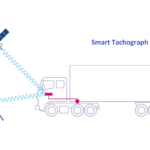
From 2019, all heavy vehicles must be equipped with a new Smart Tachograph, an improved version of the already existing digital tachograph which monitors and records the driving and resting times of professional drivers.
Smart Tachographs include a connection to the global navigation satellite system (“GNSS”) facility, a remote early detection communication facility, and an interface with intelligent transport systems, which will make it easier for authorities to track and identify potential offenders and detect fraud.
The EU Regulation which laid down the requirements for these second-generation tachographs highlighted the need to develop technical specifications for the construction of smart tachographs, and specifically called for the introduction of security mechanisms to address security threats.
The EU regulation makes it obligatory that the type approval of the tachograph components include security related tests, functional tests and interoperability tests. The positive results to each of these tests are stated by a corresponding type approval certificate.
JRC scientists have defined the smart tachograph specifications comprising the system cryptographic infrastructure and the security requirements that the tachograph components have to satisfy during the type approval security tests.
The system security of tachographs aims at protecting the data memory and to prevent unauthorised use and manipulation of the data. Such mechanisms are mainly based on cryptographic solutions.
The JRC Technical Report, now available online, provides comprehensive guidance on the cryptographic security mechanisms and on the tachograph components, security tests and certificates. The report is intended for manufacturers, component personalisers and certification authorities involved in the development of Smart Tachographs.
The JRC has also delivered three additional products to support the introduction of Smart tachographs: the Certified Protection profiles, a Sample Cryptographic Material and a Cryptographic Material Generating tool.
The Protection Profiles contain the specifications necessary to finalise the product design from the security point of view, the Sample cryptographic material provide data that supports the implementation of new tachograph systems and the Cryptographic Material generating tool enables users to generate additional cryptographic materials which can be useful during the development and testing process.
These deliverables are an important step towards the concrete implementation and entry into service of the new European Smart Tachograph system.
Background
Tiredness and speeding are common causes of accidents among drivers of lorries and coaches. To address this issue, but also to guarantee fair competition between transport companies and decent working conditions for the drivers, digital tachographs became mandatory in 2006 on all newly registered commercial trucks and buses across the EU.
They record the driving and rest time of drivers of heavy vehicles and are used by law enforcers to verify the compliance of drivers and the transport companies with the transport sector regulations.
In March 2016, a European regulation laid down the requirements for the construction, testing, installation, operation and repair of second-generation digital tachographs – called smart tachographs – which include a connection to the global navigation satellite system (“GNSS”) facility, a remote early detection communication facility, and an interface with intelligent transport systems.
The new system will enable data download and remote checking which will make it easier for authorities to track and identify any potential offenders and detect fraud, misuse or device manipulation.
